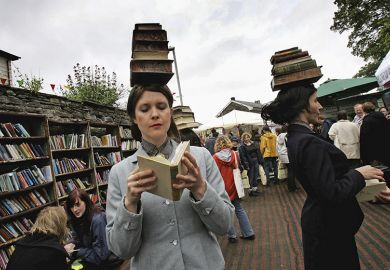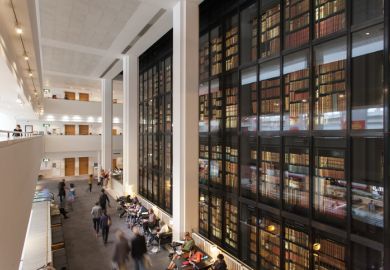Source: Dale Edwin Murray
For a journalist, there are very few stories that cling to the Velcro of memory for very long. For me, my 1973 write-up of Swansea University’s Coalfield History Project for the Times Higher Education Supplement, as this publication was then known, was one that did.
To my intense pleasure, I was recently invited back to what is now called the South Wales Miners’ Library to deliver the 40th anniversary lecture on the nature of historical memory and writing the history of one’s own times. The invitation came from Hywel Francis, MP for Aberavon and a visiting professor at Swansea, who, as part of a young team of researchers, had briefed me on the genesis of the project all those years ago.
During that spring visit, I learned that Hywel and his group used a seed-corn grant of £23,000 from the old Social Science Research Council to save the literary treasures of the fabulous libraries built up by the miners’ lodges and institutes across the South Wales coalfield, which were being sold off to book dealers at knock-down prices amid an assumption that the era of miners’ libraries was coming to an end. For example, they managed – just in time – to save all 4,000 volumes from the Bargoed and District Workmen’s Institute Library near Caerphilly.
The young rescuers were miners’ children; Hywel’s father was Dai Francis, an official within the South Wales Miners’ Federation and later general secretary of the National Union of Mineworkers (South Wales area).
One Saturday in the autumn of 1973, I went back to attend the official opening of the library. At that time, South Wales was still brimming with working pits, and the decline and fall of a great industry within the quarter of a century to come (there is now only one working coalmine in South Wales) was simply not foreseeable that shining October day by Swansea Bay. The prevailing feeling was one of carnival, not of foreboding.
Glyn Williams, president of the NUM in South Wales, stood before the blood-red banner of the Gorseinon Mountain Lodge and praised the work of Hywel’s team.
“Distinguished visitors and academics”, I wrote in the pages of the THES, “mingled with a large contingent of miners at the opening. The university’s president, Lord Justice Edmund Davies, spoke of his ‘passion for the coalmining industry’. Dr Robin Page-Arnot, historian of the South Wales miners, now in his eighties, was there in his Uzbek cap…After the ceremony, guests were treated to a high tea of beer, salad and pickle and in the evening to a concert given by the Garndiffaeth Gleemen, winners of this year’s Miners’ Eistedfodd, and the Gwaun-cae-Gurwen Silver Band.”
All that is now a world we have lost. Today’s generation does not carry in its mind’s eye the stark image of the pitwheel against the sky, or bear the memories of the disasters and deaths that regularly occurred in the tunnels below. That makes it all the more important to preserve the memory of this extraordinary industry, which saw thousands of men – viewed as the aristocrats of the labour movement – braving those dangers every day to tear the cold, black, frozen energy from the earth so that others, as well as themselves, might live broader, richer lives.
So I am delighted that the library’s rich collection of books, pamphlets, colliery files, personal records, trade union banners and recorded oral memories is being so heavily used by students today. Many never set foot on site, connecting online from Swansea’s department of adult continuing education thanks to technological advances that were also unforeseeable in 1973. Rarely can a research council speck of seed-corn have produced such a flourishing and enduring dividend.
But the physical building is worth a visit. It has the feel of a temple, especially when you look at the memorial on the wall to the 33 Welshmen who died in the Spanish Civil War – out of the 200 who fought with the International Brigade. Siân Williams might officially be the librarian, but she is also the priest-like keeper of those memories, which she imparts as she shows you around. Having recently co-written a history of the library with Hywel, her next book project relates to those banners. Some of them have emblazoned on their scarlet Francis Bacon’s great line, knowledge is power: a truth that was part of the motivating force for the establishment of all those miners’ libraries in South Wales in the 1890s.
In my anniversary lecture, I quoted the great economic historian and adult educator, R. H. Tawney. In an article he wrote for the Times Educational Supplement when invalided home from the Western Front in 1917, he called for a post-war educational system that was “generous, inspiring and humane” not just for a minority but “for all the nation’s sons and daughters”. The result of piecemeal educational reform up to 1914, Tawney wrote, “has been a system of public education neither venerable, like a college, nor popular, like a public house, but merely indispensable, like a pillar-box”.
And here’s the line to be savoured and cherished: “Only those institutions are loved which touch the imagination.” That Tawneyism fits the South Wales Miners’ Library perfectly. It touched my imagination in 1973, and it still does today.
Register to continue
Why register?
- Registration is free and only takes a moment
- Once registered, you can read 3 articles a month
- Sign up for our newsletter
Subscribe
Or subscribe for unlimited access to:
- Unlimited access to news, views, insights & reviews
- Digital editions
- Digital access to THE’s university and college rankings analysis
Already registered or a current subscriber?





